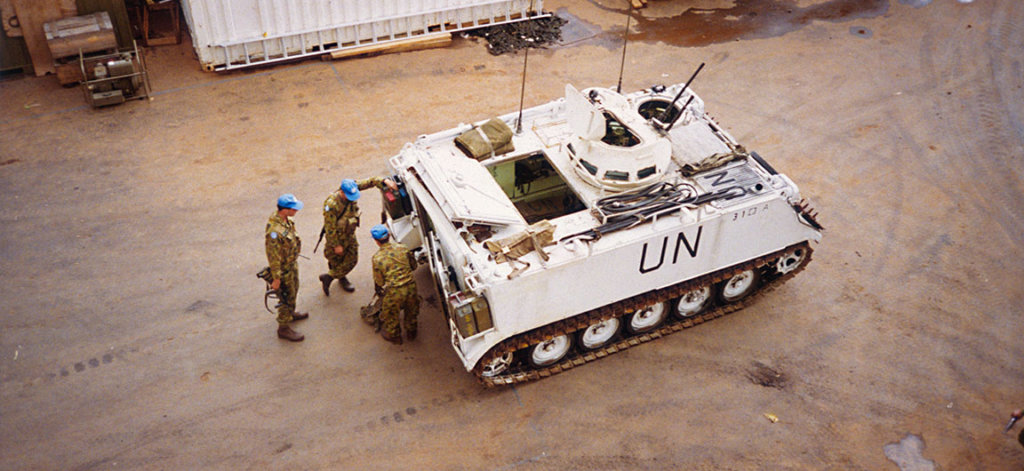Remembering Operation Tamar

Story by David Sutton. Photos by the Australian War Memorial. This article was originally published in the December 2019 issue of Reveille. It has been adapted for publication here.
In April 1995, Private Wayne Jones, 4 Platoon, B Company, 2RAR, was at Kibeho, Rwanda, when days of increasing violence exploded into all-out massacre. Troops from the Rwandan Patriotic Army (RPA), recently victorious in the brutal civil war, sought to clear an enormous internally displaced persons (IDP) camp by violent means. On 22 April they openly attacked the throngs of civilians with machetes, assault rifles, mortars and grenades. “We watched the RPA kill thousands [of people] and witnessed many murders of unarmed women and children,” Wayne recalls. “They [the RPA] seemed to be enjoying it.”
It is estimated that 4,000 people were killed on that day alone. The Australians present – a casualty clearing post with infantry support – accompanied by a Zambian infantry company could do little to stop the slaughter. They were bound by UN rules of engagement, and were so outnumbered that any action would likely have brought about their own demise. Instead, in appalling conditions, they treated the wounded and undoubtedly saved many lives.
The Kibeho Massacre
The Kibeho Massacre has come to dominate how many Australians remember the tragedy of Rwanda in the 1990s, and the extraordinary actions of the Australians present should never be forgotten, but it was only one part of a much larger story of Australian peacekeeping.
From April to June 1994, the tiny east African nation of Rwanda was the site of one of the most concentrated and brutal genocides of the 20th century. In the space of just three months, more than 800,000 people were killed as a result of bitter ethnic tensions culminating in a brutal civil war. Millions more were forced to live in IDP and refugee camps in Rwanda and neighbouring countries.
The causes of the genocide lay in long-standing tension between the two main ethnic groups in Rwanda: the Tutsi and the Hutu. The Tutsi had enjoyed privileged status under Belgian colonial rule, but since independence in 1962 the country had been dominated by predominantly Hutu governments. Over the decades, hundreds of thousands of Tutsi sought sanctuary from persecution in neighbouring countries and formed the increasingly militant Rwandan Patriotic Front (RPF). Border skirmishes were common, and in 1990 the country descended into civil war when the RPF’s military, the RPA, invaded in the north.
In April 1994 a ceasefire in the civil war was broken by news that the anti-Tutsi Rwandan president had been killed when his plane was shot down – a crime suspected by many to have been committed by Hutu extremists hoping to trigger anti-Tutsi reprisals. Hutu militias and Rwandan troops, encouraged by anti-Tutsi government propaganda, began widely and indiscriminately attacking Tutsi and moderate Hutu civilians.

United Nations Intervention
United Nations intervention in Rwanda pre-dated the genocide, and the resources made available were never enough to stem the increasing violence. In October 1993 the UN agreed to the establishment of the UN Assistance Mission for Rwanda (UNAMIR), which replaced previous UN and Organisation of African Unity (OAU) observing missions. UNAMIR was to oversee an uneasy peace agreement between the Rwandan Government and the RPA, but the small international force could do little to stop the bloodshed when the genocide erupted in April 1994.
Australia did not at first provide any assistance to UNAMIR, but did contribute to the mission after it was expanded (and informally dubbed UNAMIR II) in May 1994. Operation Tamar, as it became known, involved the Australian provision of a medical support group consisting of a medical company, an infantry company and logistics personnel. Two contingents of Australians – a total of 652 personnel – served in Rwanda between 7 August 1994 and 23 August 1995.
The First Australian Services Contingent (ASC1) established medical facilities in Kigali, the capital, and small towns such as Butare and Cyangugu. They faced unspeakable conditions dealing with death, disease and destruction in the aftermath of the genocide. In January 1995 the Australians treated the wounded at the IDP camp at Busanze after RPA troops attacked crowds throughout the night in an effort to force the internal refugees to return home.
The Second Australian Services Contingent (ASC2) began to arrive in late February 1995; it continued the medical work in Kigali, and spread its operations further afield. It was members of ASC2 who bore witness to the brutal massacre at Kibeho.
In July 2019, in a fitting recognition of their extraordinary courage, discipline and compassion throughout their deployment, personnel who served in the First and Second Australian Services Contingents in Rwanda were awarded the Meritorious Unit Citation. The legacy of service in Rwanda continues to affect many veterans of Operation Tamar to this day. Australians are rightly proud of the work they did and the many lives they saved.
David Sutton is a historian at the Australian War Memorial. He acted as historical advisor on the memorial’s new exhibition The Courage for Peace, which runs until September 2020.






